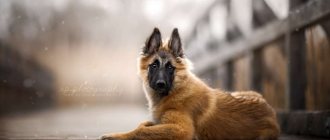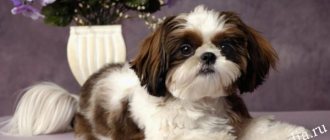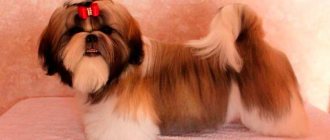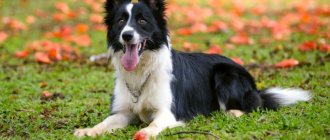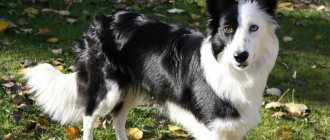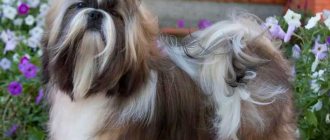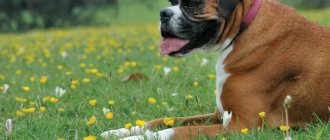| Origin: | Scotland |
| Usage: | Shepherds, companions |
| Color: | Grey; brown with a reddish tint; brown with an ocher tint; black; sand |
| Dimensions: | Height 51-57 cm, weight 18-28 kg |
| Lifespan: | 13-15 years old |
| Other breed names used: | Hairy Collie, Bearded Colli, Beardie; Highland Collie, Mountain Collie. |
The Bearded Collie (biardid) is an example of loyalty, charm, curiosity and perseverance. Long hair that hangs down the sides does not need trimming. It gives the dog charm and an unusual look. Each dog has a distinctive feature - a beard and mustache, which can be seen in the photo of a bearded collie. The docile, non-conflict nature makes the Biardid attractive for keeping as a companion dog.
Features of the Bearded Collie breed
Male bearded collies weigh up to 30 kilograms, females are a little more graceful - 18-20 kg. The height of the “boy” is up to 56 cm, the female – up to 50.
The Bearded Collie breed originated in Scotland. Her pedigree includes local bobtail herding dogs. There are genes of the Komondor and even the Polish Shepherd.
Brief historical background
Due to the long history of the origin of bearded collies, it is not possible to establish for certain when and how this happened. In addition, no historical documents were found where shaggy-haired shepherd dogs appeared. There are several versions of the development of events. According to one of them, at the very beginning of the 16th century, Polish lowland shepherd dogs accompanying them were brought to Scotland along with sheep. As a result of crossing these alien dogs with local herding dogs, shaggy, hardy shepherd dogs were obtained, adapted to the harsh climatic conditions.
Adherents of another theory authoritatively claim that Birdies originated from long-haired Scottish collies and bobtails. As evidence, they cite a strong visual resemblance to the latter. The third version connects the appearance of bearded men with commanders or kuvasz. Others consider bearded collies to be natives of Central Asia, from where they were brought by nomads.
Bearded collies are very similar to bobtails, they are distinguished only by the presence of a tail.
However, the official chronicle of the breed begins only in 1891, when the birdies were described in detail by Thomson Gray in the literary work “Dogs of Scotland”. In Edinburgh at the beginning of the 20th century (1912), the Scottish Club of Bearded Men was founded and the first breed standard was developed; in 1955, a similar organization was created in England. In 1964, the standard requirements underwent changes and were finalized. The international canine community recognized bearded collies in 1967. The breed is entered in the FCI register under number 271 (group 1 - herding and cattle dogs, except Swiss cattle dogs, section 1 - shepherd dogs). This current breed standard dates back to October 28, 2009 .
Bearded collies appeared on the territory of our country at the end of the last century, but they are not particularly popular, and their numbers are small.
History of the Bearded Collie
The Scots were the owners of a couple of types of this type of dog. One of them is quite small and very fluffy, the second is larger. It was intended for grazing livestock. Her fur was heavier and longer.
The modern Collie from Scotland represents a tandem of the above breed types and, in addition to what is called the “bearded”, is simply called the “Scottish Collie”. They are also called “herding dogs.”
Airedale
- Height: from 56 to 61 cm
- Weight: from 18 to 29 kg
- Life expectancy: 10 to 12 years
- Temperament: intelligent, sociable, friendly, alert, confident, courageous
The Airedale Terrier is known as the "King of Terriers" , a title earned for its tall stature, strong build and stellar reputation as hunters, wartime messenger dogs, athletes and family companions. But they are also worthy of the title “Kings of Bearded Dogs,” as few breeds can boast such magnificent mustaches and long beards—perhaps due to their majestic long noses. Whether it's dirt, water, dog food, or other debris, Airedale beards will find it, so be prepared to wash your pet's face daily, as well as wipe up any droplets he leaves behind.
Scottish Collie color
The photo of a bearded collie shows dogs of a wide variety of colors.
The most common colors:
- Black.
- Gray or piebald.
- Blue.
- Gray with white markings.
The original color of a bearded collie puppy can change over time, and even dramatically. During the first years of life, the animal can darken, or the fur will acquire a light shade. The final color type is established at 3-4 years.
The babies in the litter are often black or brown. As they grow older, their fur becomes lighter or remains approximately the same as at birth. Brown puppies may become even darker, almost black.
Health
The bearded collie dog breed is distinguished by good health and a long life span. With good care - up to 16 years.
Diseases
There are a number of diseases that are most common in biardid:
- Ocular - conjunctivitis, glaucoma, cataracts.
- Allergy.
- Hip dysplasia.
- Ear pathologies.
It is worth noting that hip dysplasia is a hereditary disease of biardids. When selling a puppy, the breeder must provide a certificate confirming that the parents do not have dysplasia.
Vaccinations
No animal is immune from such dangerous diseases as plague and rabies. Unvaccinated biardids pose a danger to other pets and people. Mandatory vaccination is carried out according to an individual schedule agreed with a veterinarian.
Before vaccination, a number of rules are observed:
- The dog must be absolutely healthy.
- Treatment for fleas and worms is required. The presence of parasites may reduce the effectiveness of the vaccine.
- At least three weeks must have passed since the previous vaccination.
Table No. 2 shows the standard vaccination plan.
Table No. 2.
| Puppy age | Types of vaccines |
| 8 weeks | The first comprehensive vaccination against distemper, parvovirus, and leptospirosis. |
| 12 weeks | Revaccination against the above diseases |
| 6 months | Second complex vaccination + against rabies. |
| 12 months | A comprehensive universal vaccine against all of the above diseases. |
The following vaccinations are carried out once a year throughout the dog's life.
Characteristics of a Bearded Collie
These dogs cannot imagine their existence without people. The description of the Bearded Collie says “an absolutely social dog.”
- She is ready to learn for the rest of her life, is very devoted to her owners, loves children and is quite friendly with kids.
- The Bearded Collie is a full-fledged member of the family. He is ready to participate in everything that concerns his household, their life and affairs.
- These pets get along well with other animals, even if there are cats or hamsters in the house.
You should introduce collies to strangers carefully, as the dog may bark loudly, which will frighten the new pet. But then the bearded regular at home will happily receive the guest.
How to choose?
If you have finally decided to get a bearded dog, then the first thing you should do is decide on a specific breed. In this sense, it is important to consider several factors.
- Appearance. It's no secret that we all want to have a beautiful and cute animal. However, in addition to subjective external signs, close attention should be paid to the size of the animal. Compare the size of the dog with the living space available to you. You should carefully consider whether the animal will fit in your apartment, whether it will be comfortable for you and the dog to coexist in the same area.
- Behavior and character. Before purchasing a puppy of a particular breed, carefully study the information regarding its character traits. For example, some animals do not get along well with children, the elderly, or other pets living in your home. Other species cannot tolerate prolonged loneliness. It is important to analyze such characteristics of the animal so as not to get unpleasant surprises later.
- Physiological needs. In this regard, it is important to understand what specific care the dog needs. For example, some breeds like to spend most of their time outdoors. There are varieties that require constant medical examination. Make sure that you can support all these activities from a financial, time and energy perspective.
Once you have decided on a specific breed, it is important to find an official nursery that breeds similar animals, or contact an individual breeder. One way or another, you should make sure that you are buying a purebred and healthy dog. To do this, check out the certificates and licenses, as well as other documents available to the seller.
The external condition of the puppy and its behavior are also important factors. The animal must be well-groomed and active.
If possible, examine the parent pair to ensure that the puppy was born from healthy parents and has not inherited any genetic diseases.
How much does a puppy like this cost?
The price of a Bearded Collie depends on a number of significant circumstances.
- The cost of puppies with a pedigree is from 40 to 60 thousand rubles.
- Everything determines the type of pedigree, the status of the nursery, the opportunity to participate in exhibitions and shows.
- Without documents, a dog can be purchased for 10-15 thousand rubles.
Lhasa Apso
The Lhasa Apso is another dog that is known for having quite a lot of facial hair, including a distinct beard. Their long coat kept them warm in the harsh climate of the Himalayas in Tibet, where they were originally from.
Although they are attached to their family, they can be a little distant from strangers. Warning barking is common in this breed, and you may need to work on training an alternative behavior if this becomes a problem.
Lhasa Apso requires special care. Their coat is constantly growing, and if your dog has a long, flowing show-style cut, they will require daily grooming to prevent knots and tangles from forming. Some owners prefer a shorter haircut. This is much more practical, but will still require regular maintenance.
All of the bearded dog breeds on this list have their own unique characteristics. If you're drawn to a certain breed, it's important to do your research to see if their temperament, grooming, and exercise will suit your lifestyle.
It's also worth being prepared for a little drool and regular beard trimming and brushing to keep things under control!
What physical activity is most optimal?
This is an active dog. She will be happy to run around with the children in the yard.
- You can exercise your bearded collie often, or no more than an hour a day.
- They simply love to play and are also obedient and quick to pick up a scent.
- In addition, the Bearded Collie definitely retains the herding instinct.
This is also why you can safely leave your dog with your child for a walk or ask him to “help” in looking after other pets. By the way, the Bearded Collie has a natural flair for truffles.
Skye Terrier
The Skye Terrier is a short, bearded breed (up to 24 cm at the withers), first bred on the island of the same name, located off the coast of Scotland. Distinctive features: dense muscular body, round brown eyes and pointed ears. The color can be anything: from white to black. These pets are suitable for sharing with older children who understand the basics of interacting with an animal. After all, Skye Terriers do not accept disrespect for personal space, assertiveness and annoyingness. They decide for themselves when they are ready to communicate. Walk for at least 30 minutes every day. At home, equip a special bed in the place your pet chooses. Do not have other domestic animals indoors, otherwise they will become a source of prey. Bathe your dog at least 2 times a week using special hypoallergenic shampoos.
Skye Terrier
Conditions and care for a bearded collie
You can keep a dog of this breed either in your own home or in an apartment. There is no need to put the bearded man on a chain, he does not accept this. It is good if the pet is assigned a certain place - its own bed or a small sofa.
- The most important thing in grooming is to keep your pet's coat in order.
- Careful care involves daily brushing with a stiff brush.
- Don't assume that light brushing of the outer coat is enough.
- This way the cover will quickly fall off, the dog will resemble a rolled up felt boot.
- You should try to comb the fur from the skin itself. The dog needs to be taught this from early childhood.
Once every couple of months, it is advisable to take your pet to a professional dog groomer. A specialist will eliminate flaws in the wool if the owner was unable to more carefully and fully care for it.
Collies need to be washed once a month. If it's really required. When the coat is relatively clean, you can wait a couple more weeks. Before water procedures, the dog is thoroughly combed.
Appearance
The post-war revival of the breed affected the exterior. To begin with, the breed standard was changed, but the changes affected only the dimensions of the dogs. Further, Birdies were divided into three types:
- Old-type dogs are dogs that carry the blood of shaggy shepherd dogs. They are distinguished by a rougher, working appearance and head shape.
- Potterdale is a show variant, named after the kennel that bred exterior dogs. It is this type that most often appears in photos in the media.
- Mixed is the most popular type, obtained by mixing the two above. Dogs of the transitional type have a decent exterior and moderately developed working qualities.
Animal nutritional pattern
Your Bearded Collie's diet should include a balanced diet. Which? The veterinarian will advise you based on the pet’s health, weight and age.
Be sure to have a large drinking bowl next to the feeders. Your bearded collie should have access to it 24 hours a day.
- Feeding is provided twice a day.
- It is important not to give your dog table food, especially sausages or foods that cause flatulence.
- After such “goodies” the pet may become ill and will have to be taken to the veterinarian.
Chickens Hercules characteristics
Hercules chickens were bred relatively recently and have won a place of honor throughout the CIS countries. The breed was bred thanks to the painstaking work of Ukrainian breeders from the Poultry Institute in 2000, in the city of Kharkov, under the strict guidance of Professor Yu. V. Bondarenko. It took scientists more than 10 years to breed a breed that has all the declared characteristics. Selection was carried out in a rather complex way by crossing various gene pool species of chickens with broilers. The bird received such a modest name due to its large size and excellent egg production.
As a result of complex interbreeding, chickens of the Hercules breed acquired the following types of colors:
- Cuckoo;
- White;
- Golden;
- Pockmarked;
- Silver.
These birds have an incredibly massive and large body and a medium-sized head. The wide body is located on legs of medium height. The eyes are orange, the beak is yellow, the crest has a leaf-shaped red color with 4-6 teeth, the earrings are red or light. The rooster's tail is always small.
The bird's character is calm and its immunity is strong. When kept with other breeds, the Hercules breed tends to dominate. Immunity is excellent, survival rate is high, about 92 - 94% of the population survives to adulthood.
Chicks of the breed develop according to the broiler type and by 63 days, with appropriate nutrition and proper care, their weight can reach up to 2.2 kg. As a rule, by the first year of life, the weight of the rooster is 4.2 - 4.5 kg, and the weight of the hens is 3.5 kg. However, it is worth noting that the indicators declared by the manufacturer are slightly different from the actual ones: the weight of fattened roosters varies from 6 to 7 kg.
Experienced poultry farmers and research institutes note that among all the available colors, individuals with a white color have the most attractive qualities and are distinguished by their maximum body weight during fattening.
Egg laying in chickens begins 4.5 - 6 months after birth and during the year they lay about 190 - 220 beige eggs, the weight of each varies from 64 to 70 grams. Compared to eggs of other breeds, the yolk predominates in the mass of the egg and accounts for 34%.
Should a Bearded Collie be trained?
They are independent but very obedient animals. But at the same time, it is advisable to teach the dog to discipline. This is not difficult to do; a bearded collie is highly trainable, and some representatives of the breed can even be taught a large number of “tricks.”
- Teaching methods should be unobtrusive, consistent, and firm.
- Moreover, it is important to remember that you should treat your dog with love.
- The Bearded Collie will enjoy any type of training.
- The main thing is that the reward is received in the end.
- You can teach your pet games or engage him in dog sports.
The main thing is to engage, pay attention and have unlimited sympathy. The dog will respond in kind and there will be no problems with its behavior.
It is better not to leave small children alone with a dog, but it is advisable to explain to older children how to properly deal with a four-legged pet.
Irish Blue Terrier
The Irish Blue Terrier, or Kerry Blue, is an elegant, stately dog with soft curly hair, a funny long beard and bushy eyebrows. Distinctive features: stubbornness, attentiveness, excellent attitude towards children. Be sure to be strict when training, otherwise the Kerry Blue may become willful and show character. Remember the basic rule of communicating with a blue terrier: never shout or raise your hand at the animal. Otherwise, you risk losing full contact with your “true friend.” The coat of these dogs is single-layer, so it practically does not shed. The main thing is to teach your pet to go to the groomer from puppyhood. There are no special instructions regarding catering. The number of feedings is 4 times a day.
Irish Blue Terrier

